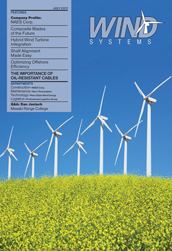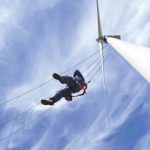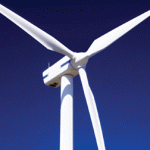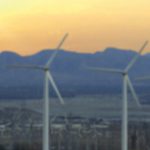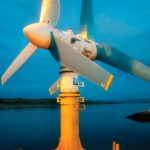Until now, the wind power industry has been moving forward at a relatively steady climb. The onshore industry is powered today primarily by two types of drive train technologies: one based on double-fed induction generators, and the other based on permanent-magnet generators (PMG). Double-fed induction generators have been a good choice for smaller powers in onshore installations. At less than 2MW, they prove to be competitive in price and performance. However, when moving offshore, double-fed induction generator drive trains are no longer a viable option. With extra components, slip rings, and greater losses, the risk of maintaining at sea is simply not one that wind turbine manufacturers are willing to take.
Therefore, critical components used offshore must unquestionably be more reliable than their onshore counterparts. Unscheduled maintenance is extremely difficult, and even though offshore winds are in fact more consistent, wind turbines must be able to withstand powerful storms, corrosive elements, and turbulent atmospheric conditions.
The drive train and all other critical components must have an exceptional track record onshore before they have a chance to be considered for the much more challenging offshore application.
The Next Frontier
At the same time that offshore is gaining momentum, wind farm owners and utilities are moving toward higher powers with onshore installations. The 3MW range of wind turbines are quickly taking over as the new mainstream power for onshore. For these new wind turbines, the obvious choice is PMG. That is because PMG offers superior energy output, even at partial loads. Furthermore, PMG guarantees proven reliability in highly volatile wind conditions and better quality energy for the grid. Therefore, most of the major wind turbine manufacturers have now switched over to this next-generation drive train technology. Figure 1
Other new trends that are emerging in the 3MW onshore range are that turbines are featuring bigger rotors and longer blades to be able to capture more energy from winds at low speeds. Here, too, PMG is ideal. Permanent magnet generators come in a range of speeds—low, medium, and high—with each filling a specific need when it comes to the environmental and wind conditions in question at the actual site of installation. Offshore is now showing more encouraging signs of taking off in a big way, with new projects getting green lights in different parts of the world. Many believe—as we do at The Switch—that offshore wind generation will be the next new frontier.
A few European countries such as the U.K., Germany, Belgium, and Denmark are leading the growth. Other European countries are currently struggling to obtain permits while the United States, although enthusiastic, is still wrestling to get the financial backing required. Another trend is the increase in power classes, from multi-megawatt to offshore-class turbines of 6MW through 8MW, and even up to 10MW of power generating capability. The technology for these super-power offshore turbines already exists, in fact.
Offshore Electrical Drive Trains
As far as we have seen at The Switch, it is extremely difficult to deploy turbines with a double-fed induction generator for offshore use. We already have had success with our 4MW direct-drive PMG and full-power converter packages now operating in some of the gustiest coastline conditions in Norway. The Switch has been focusing on providing optimized PMG and full-power converter packages since the company’s start in 2006. Today it has 5GW of installed capacity throughout the world in all kinds of challenging operating conditions. Figure 2
As we currently prepare our concepts for optimized 6MW and 8MW offshore-class packages, we’re planning to take two paths ahead. Although direct driven offers the ultimate in reliability and efficiency that is so critically needed in offshore applications, the generator alone can easily weigh up to 150 tons at these high power ratings, creating challenges with handling and overall costs. Therefore, we see that the direct-driven PMG drive train is the best option and most competitive for power ratings ranging from 1.5MW to 8MW.
For power ratings of 3MW up to 10MW, a medium-speed option may be the best bet, in his opinion, with reliability nearly as high as direct-drive drive trains. The Switch—together with another Finland-based company, Moventas—has launched a revolutionary wind power drive train called FusionDrive™, which provides an optimum balance of lighter weight and high reliability rates with its integrated gear and medium-speed drive train. FusionDrive is specifically designed for a power range from 3MW to offshore class. Additionally, the lightweight medium-speed model is compact, offering lower lifetime costs.
An Integrated Solution
FusionDrive offers optimal availability by harnessing all the advantages of medium-speed wind power generation technology. It is extremely compact in size and offers the lowest weight in the market. “The lower the nacelle weight, the more cost competitive the turbine,” adds Jukka Jäämaa, CEO of Moventas, one of the biggest wind gear manufacturers in the world. “Nacelle weight relates directly to both foundation and construction costs of the turbine as well as manufacturing, transport, and assembly costs in the whole supply chain.”
The FusionDrive integrated solution with perfect alignment between gear stages and the generator, along with an integrated lubrication system, simplifies the nacelle structural design, which lowers the nacelle weight and improves total turbine cost effectiveness. The low number of bearings, low cogging torque, and the construction with no current passage through bearings, slip rings, or rotor windings also contribute to the proven reliability of medium-speed technology. Figure 3
FusionDrive uses medium-speed wind power generation technology, as it has been proven for the highest possible availability in wind power generation. It is designed on a scalable platform that extends from 3MW to offshore class, all in an onshore size. The compact size of the complete drive train allows easier transport and assembly.
Ingenious Fusion
For wind park owners, reliability in practice means high availability and lower operation and maintenance costs. In addition, FusionDrive guarantees optimized efficiency, even at partial loads. Regardless of which path turbine manufacturers feel is best to go out to sea, these two paths forward will help them stay ahead of the pack.



















